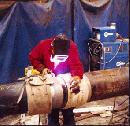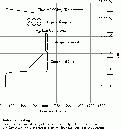
By: Mike Roth, product manager, Miller Electric Mfg. Co.
In the power piping industry, typical turn-around time on a boiler pipe project ranges from 20 to 36 weeks. J.F. Ahern Co. (JFA), Fond du Lac, Wis. - ranked as one of the Midwest’s top 10 mechanical contractors according the May 2002 Contractor magazine - isn’t typical.
“Our turn-around time averages eight to 12 weeks, and that includes pipe made from P91 chrome-moly steel,” states J.F. Ahern's Tom Krenn, plant superintendent, Pipe Fabrication Division. “We stake our reputation on quality, pricing and delivery. Using induction heating technology from Miller Electric Mfg. Co. supports all three of our selling points. On P91, it’s reduced our pre-heating time from 2 to 2-1/4 hours or more to 30 to 60 minutes. It reduces hydrogen bake-out time, too. That’s money to the bottom line.”
J.F. Ahern is one of the first fabricators to switch from direct heating methods (propane flame or resistance heating with “ceramic pads”) to induction heating, an indirect method that heats pipe from within. Krenn, a cautious man, carefully evaluated all three heating methods before selecting one for use on P91, a particularly difficult metal to fabricate. Assisting him was Peter Flood, manager of Airtec, Inc., his welding supply distributor in Fond du Lac.
Power Pipe Trends
Founded in 1880, J.F. Ahern has grown from a small plumbing, steam and hot water heating shop to a $120 million per year business. Today, the company provides process piping, mechanical service, water/wastewater treatment, plumbing, HVAC and refrigeration services. The Pipe Fabrication Division serves the power generation, petrochemical, food and beverage, pulp and paper, pharmaceutical, automotive and water/wastewater customers. It can provide turnkey services, fabricate pipe to customer specifications and assist with system layout, budgeting and takeoff.
Much of its work today involves spooling pipe for the large, multi-national engineering firms and mechanical contractors that are erecting new plants or upgrading aging facilities. By the end of this decade, hundreds of power plants will be built or refurbished. Whether old or new, much of the pipe that carries the high-pressure steam to the turbines is now made from a newer alloy. This newer grade, 9Cr-1Mo-V (P91) steel, offers a much better strength-to-weight ratio than “the old standby” 2-1/4Cr-1Mo (P22) steel.
“A 26-in. diameter main steam line made from P91 can have a wall thickness of 2-1/2 in. With P22, you’d be looking at a product almost 5 in. thick,” notes Krenn. “It holds up better, too. These parts are wear items. Would you want to replace something every five years or spend the money up front and have it last 15 years? As a result, engineers are specifying P91 to get longer life out of the power houses.”
Five years ago, Krenn estimates that perhaps 10 percent of his work involved chrome-moly steels. Today, it comprises more than 50 percent. Achieving so much chrome-moly volume happened because customers respect J.F. Ahern’s ability to produce a quality product with this difficult-to-work-with metal.
“A weld is only as good as your control. If you don’t weld in a controlled environment, you’re going to have problems,” says Krenn. “With P91, one key is to maintain the proper preheat temperature, interpass temperature and hydrogen bake-out temperature.”
Preheating, typically to 400 to 550 degrees Fahrenheit, drives off moisture and thereby reduces the hydrogen content of the metal. Hydrogen embrittlement can lead to cold cracking of the finished weld. For this same reason, maintaining interpass temperatures (the temperature between welding passes) and a hydrogen bakeout of the finished weld are also required by various codes. Depending on the application, codes that apply include ASME B31.1 Power Piping, ASME B31.3 Chemical Plant and Petroleum Refinery Piping and ASME Section I Power Boiler Parts. These codes also require post-weld heat treatment, but J.F. Ahern subcontracts this activity to an outside firm with an oven that can heat three or four 14,000-lb. pieces of pipe at once.
Reducing Time to Temperature
With more of his work involving P91 and the work demanding stringent quality control, Krenn sought to improve his heating methods. Like most fabricators, J.F. Ahern previously used propane flame heat. However, “Most of our P91 customers do not want it. They do not trust flame heat to heat the pipe uniformly throughout its thickness, maintain interpass temperatures or minimize the heat-affected zone,” says Krenn. “With flame, you’re always taking a temperature stick (a crayon-like stick that melts when it reaches a specified temperature), checking the temperature, adding more heat, watching for the heat to drop, adding more heat and so forth. Flame heat can be too inconsistent to ensure proper quality with P91.”
Seeing Krenn’s concern with quality, Airtec’s Flood arranged for a demonstration and trial test of Miller’s inverter-based Induction Heating Power System (IHPS). This system uses a rapidly alternating (10 to 20 kHz) electromagnetic field in a flexible coil. The magnetic field crosses the part and induces current flow (eddy currents) within the part, creating heat. See Fig. 1 and 2 for more details (“How it Works” diagram and application photo).
The induction process does not rely on conduction to heat the part, so the coils do not heat up. The source of heat is just under the surface, where 87 percent of the heat is created by eddy currents. This makes the process extremely efficient in its use of energy, which is why it brings parts to temperature so quickly and why an induction heating system only requires a 45-amp, 460-volt circuit. Induction heating technology’s efficiency also ensures more uniform heating of thick sections from the inside to outside diameter, and it ensures uniform heating at the top, sides and bottom of the pipe.
“The benefits of induction heating technology quickly attracted Krenn,” says Flood. “It’s much faster, cleaner, safer, one-man portable and has a lower consumables cost than flame or resistance heating. Going from two to four hours to raise a part to temperature to just minutes to temperature requires shifting their mindset. ”
Typical applications include pipe butt joints, pipe weldolets, pipe-to-valve connections, pipe to elbows, pipe to T-sections, nozzles to pipe and vessels and reducers. “With preheating these parts made from P91,” notes Flood, “the induction process can be up to six times faster than resistance heating.”
Comparing Alternatives
Like most superintendents making an important decision about using a new technology, Krenn also gathered data on resistance heating - a more traditional method - before making a decision.
“We had a provider of resistance heating systems in here for a demonstration,” says Krenn. “We compared both resistance heating and induction heating technology, so we know for a fact what they can or can’t do. The bottom line is - Why would I want to spend hours bringing a part to temperature when it can be done in minutes with induction heating? There would be times where you would have a man who’s not welding, and that’s money lost.”
In Krenn’s eyes, resistance heating also wastes time because it requires one to several hours to wrap the heat-conducting ceramic beads around a joint, wrap the beads with insulation and then hold everything in place with tie wire.
“It’s nice to set up six resistance heating heads (most systems are ‘six-way’ systems), but it takes hours to set them up,” notes Krenn. “With induction heating, we’re set up in 10 to 15 minutes. For set-up, we weld a thermocouple on the pipe, wrap a simple blanket around the pipe and wrap the pipe with the induction coil. Our operators can finish their welding with induction heating before the part would even be up to temperature with resistance heating.”
He also notes that the insulation used with resistance heating “turns to worthless snowflakes when you pick it up” after two uses. The silica needle mats used with induction heating typically last for 50 operations. “Induction mats don’t break down, so you can reuse them. This considerably lowers our monthly consumables cost,” says Krenn.
The induction blankets serve two purposes: First, they prevent the joint from losing heat to the atmosphere. Second, they protect the induction coil and the welding operator from direct contact with the hot pipe.
“Our operators won’t burn themselves handling the induction coil or mats. You can’t say that about hot ceramic beads,” says Krenn. The silica needle mats remain so cool that operators can actually rest their arms on them while welding (see photo). Airtec offers mats for standard size joints (6-, 10-, 14-in. diameter pipe, etc.), and they can create custom sizes shapes, such as for a weldolet.
Proof Positive Quality
Perhaps the fact that Krenn is most proud of is that induction heating technology allows him to guarantee the specified temperature and temperature consistency.
“With Miller’s induction system, we can produce a hardcopy graph (see Fig. 3) and download all our heating data onto a disk. We give that disk to a customer’s quality control department because they require it. Customers definitely have a lot more confidence in J.F. Ahern because of it.
“We’re happy not just because our customers are happy, but because induction improved our productivity considerably. Our turn-around times are among the fastest.”
J.F. Ahern is moving forward at a very fast pace in a very competitive, quickly growing market. They will be setting the pace for others to follow.



